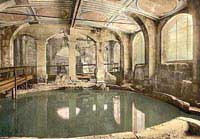 |
The famous hot spring bath in Bath, England (Photo: VNE) |
Bathing in hot springs, shopping in the suburbs, and dining out seems like the routine of a wealthy urbanite today. However, it also mirrors the lifestyle of an English resident in the 1st century AD.
Archaeologists in the city of Bath, England, have identified an ancient suburban area located outside the city center. Similar suburban areas from the Roman era have been found outside major cities like London, providing further evidence that suburban living is not merely a modern phenomenon.
Tim Robey, Project Director at the Bath Archaeological Society, stated that during the Roman period, a wall was constructed surrounding the city center of Bath, which included the famous hot springs, the temple of Sulis Minerva, and possibly a large theater yet to be discovered.
Apart from a few religious leaders and officials living in the city, most residents moved to the Walcot area, a suburb just 800 meters north of the city center. Walcot essentially comprises a main thoroughfare similar to Park Avenue, flanked by streets on both sides, all leading to a junction connecting to London Road for entry into the city.
According to Robey, like most suburbs today, the people of Walcot were also divided into various social classes. “Rickety wooden huts mixed with luxurious buildings, including those made of fine stone. The residents of Walcot could have included monks, bathhouse attendants, artists, shopkeepers, and clerks.”
Robey speculated that the ancient suburban residents did not shop at a central market but rather at smaller shops scattered throughout the area. The discovery of a hammer fragment and iron rust suggests there was once a blacksmith workshop. Paint pots, fragments of green glass, and materials found in the enamel layer evoke traces of a painting workshop. Other remnants indicate there were also shops selling silverware and ceramics.
Particularly intriguing for British archaeologists is the discovery of the foundations of 6-7 luxurious villas, which may have served as residences for wealthy urban dwellers. Typically, such villas were built away from the bustling, dusty city center, but in this case, they were constructed right on the valley slope near Walcot.
It is possible that the owners of these villas could not resist the allure of Bath. “Bath has the only hot springs in England, and the city was known throughout the Western Empire during the Roman period.” Robey remarked.
Robey and the archaeological team hope to further study these villa sites to gain insights into the lives of Bath’s suburban residents during the Roman era.
M.T.



















































